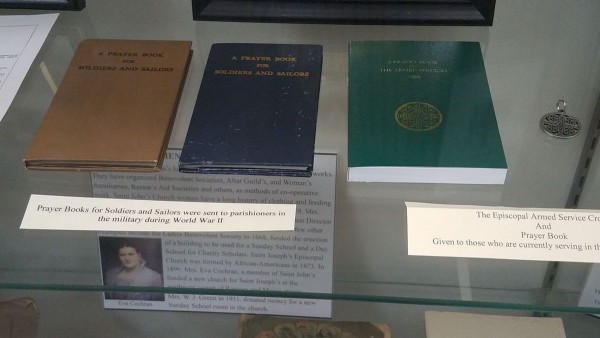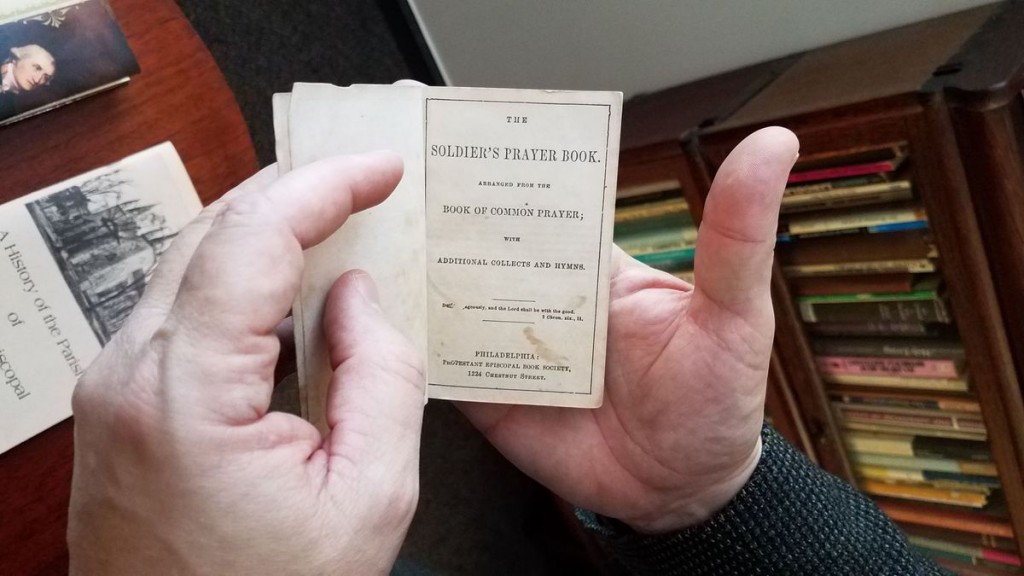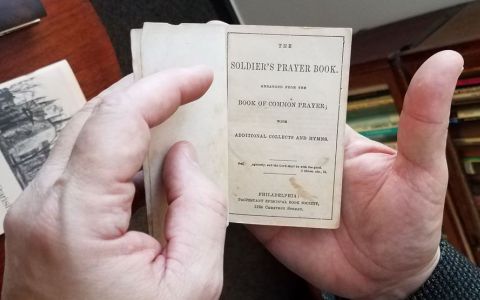
Prayer books from World War II and the modern era are on display in a case at St. John’s Episcopal Church on Green Street downtown.
The little Episcopalian prayer book did not have the easiest journey to the Rev. Robert Alves’ private collection.
“This one has actually been in the ocean,” says, Alves, holding up a leather-bound copy of the Confederate Book of Common Prayer.
In 1863, the book was part of a shipment of devotionals headed to Confederates in the battlefield. But Union ships were in hot pursuit of a Rebel blockade runner carrying the devotionals and other supplies off the coast of Beaufort. The Confederate sailors, before eventually running aground, dumped cargo to lighten the load, including the books.
U.S. Naval Commander Daniel Boone Ridgely rescued the books from the Atlantic, along with other supplies. Ridgely, an Episcopalian, sent the book to a priest in Maryland, A.C. Coxe, says Alves.
Alves, rector of historic St. John’s Episcopal Church in downtown Fayetteville, bought the prayer book from a rare-books dealer in Connecticut. He collects devotional manuals and prayer books, and has a particular interest in ones used by soldiers on both sides of the Civil War.
“They are scarce,” he says, seated in his office of the church, which is celebrating its 200th anniversary. “Both before the internet, and are still scarce after the internet.
“We really don’t know how many are out there. Not a lot of people are collecting devotional manuals as a collection. There were some who did right after the war. Duke and other libraries have extensive collections. But others have either been lost to time, because they were used, or lost to fire or whatever.”
Families have understandably held on to and passed down others, he says.
Collector
Alves stresses that the most-used devotional resource by soldiers in the Civil War was far and away the Bible. Still, thousands of soldiers on both sides carried the prayer books, which incorporated elements of the English Book of Common Prayer. They used them for personal devotion, or chaplains would use them for services, sacraments or funerals.
The Army and Navy Prayer Book, prepared by a bishop in Richmond, was the most common on the Confederate side, he says. For the Union, it was the Soldiers and Sailors Prayer Book, distributed by the Episcopal church and aid organizations.

The Rev. Robert Alves shows the inside of The Soldier’s Prayer Book, which was used by Union soldiers during the Civil War.
Alves buys the prayer books online or at Civil War shows, which he attends a couple of times a year, usually in Richmond. He estimates he owns about 20 historic prayer books and 15 devotional manuals.
He spends an average of eight hours making clam-shell cases for the books. In this way, he saves money doing the book preservation himself; but he also enjoys making the cases and custom-fitting them to the books. He says initially he would consult his late father-in-law, who retired as a curator of rare books at the University of Virginia.
He keeps his collection behind glass.
“Books like what people like,” he says. “Lower and moderate humidity and a stable temperature range. Excess moisture or excess dryness damages them.”
Common denominator
Alves began collecting prayer books in earnest in the early 1990s, after a friend gave him one as a gift.
But his interest in the subject began earlier, when as a boy he would collect bullets, buttons and other artifacts from a nearby Civil War camp at Harrison’s Landing in Virginia.
“My father was rector of a church between Richmond and Williamsburg,” he says. “(Union Gen.) McClellan had camped in that area where the church was located. During that time period is when I developed a love of both the Episcopal church and also Civil War history.”
The books are more than pages and binding for him; they are stories.
He shows a favorite: A rare pocket manual of devotions for Confederate soldiers, printed in small quantities, and compiled by a chaplain in a Tennessee regiment. The original binding had been replaced with wallpaper.
To Alves that means the devotional was not just tucked away, but was in regular use by some soldier.
He said Episcopal leaders fully expected to reunite after the war, and for him the prayer books distributed to both sides symbolize that.
“The church did not split before the war,” he says. “It only split when the Confederacy split. The bishops in the Confederacy continued to meet in council, and they said prayers for the bishops in the North. Bishops in the North left seats available for bishops in the South.”
Alves said the church finds its greatest common denominator in Christ.
The prayer books reveal that both Union and Confederate soldiers “are relying on a higher power.”
–fayobserver.com



